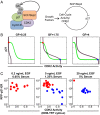Basal p21 controls population heterogeneity in cycling and quiescent cell cycle states
- PMID: 25267623
- PMCID: PMC4205626
- DOI: 10.1073/pnas.1409797111
Basal p21 controls population heterogeneity in cycling and quiescent cell cycle states
Abstract
Phenotypic heterogeneity within a population of genetically identical cells is emerging as a common theme in multiple biological systems, including human cell biology and cancer. Using live-cell imaging, flow cytometry, and kinetic modeling, we showed that two states--quiescence and cell cycling--can coexist within an isogenic population of human cells and resulted from low basal expression levels of p21, a Cyclin-dependent kinase (CDK) inhibitor (CKI). We attribute the p21-dependent heterogeneity in cell cycle activity to double-negative feedback regulation involving CDK2, p21, and E3 ubiquitin ligases. In support of this mechanism, analysis of cells at a point before cell cycle entry (i.e., before the G1/S transition) revealed a p21-CDK2 axis that determines quiescent and cycling cell states. Our findings suggest a mechanistic role for p21 in generating heterogeneity in both normal tissues and tumors.
Keywords: cell dormancy; nongenetic cell heterogeneity; positive feedback loop; synthetic uORF; tumor heterogeneity.
Conflict of interest statement
The authors declare no conflict of interest.
Figures





References
-
- Maheshri N, O’Shea EK. Living with noisy genes: How cells function reliably with inherent variability in gene expression. Annu Rev Biophys Biomol Struct. 2007;36:413–434. - PubMed
-
- Wilson A, et al. Hematopoietic stem cells reversibly switch from dormancy to self-renewal during homeostasis and repair. Cell. 2008;135(6):1118–1129. - PubMed
Publication types
MeSH terms
Substances
Grants and funding
LinkOut - more resources
Full Text Sources
Other Literature Sources

